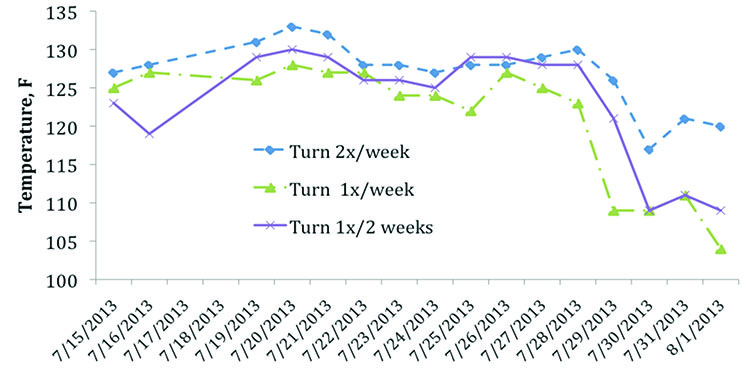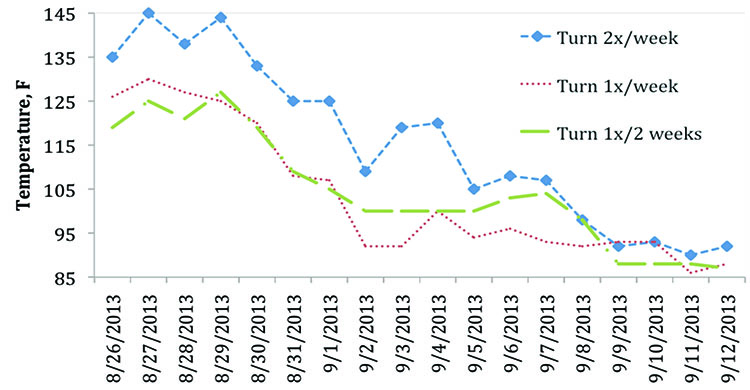Compost Turning: The Key to Quick Composting
Why Turn Compost?
The rate of decomposition of organic material depends on the makeup and surface area of the material being composted, availability of moisture, and aeration. Of these three, aeration is controlled by turning the composting organic material. Without proper aeration, microbial activity will be limited since most of microorganisms participating in decomposition are aerobic (oxygen loving). With limited microbial activity, composting would be slow. With adequate aeration, the temperature of pile rises quickly hours after composting started. There is no short cut to turning your compost to increase oxygen and engage microorganisms.
What Processes Necessitate Turning?
The center of the pile heats up and decomposes more quickly than the outer edges. With more activity, oxygen at the center of the pile depletes quickly and abundant heat is generated. The depleted oxygen must be replenished for the process to continue. Also, since organic materials are decomposed by different organisms at various stages of decomposition, turning is needed to revitalize some of the microbes needed for decomposition to proceed, but halted by microbial death due to too much heat.
What Factors Affect the Frequency of Turning?
Frequency of turning depends upon the thickness and makeup of the layers of the composting material and the correct balance of brown (carbonaceous) and green (nitrogen rich) material. Generally a one-to-one ratio by weight is recommended. The size of the composting material and the type of composting structure also affects the frequency of turning. Tumblers are generally easy to turn and several turnings can be done as needed. Ground structures such as cement blocks, and pits are difficult to turn frequently.
Frequency of Turning
As a rule of thumb, actively decomposing materials should be turned every three to four days. Materials with slowed microbial activity can be turned less often.
In tumblers, turning two times a week resulted in higher temperature and faster decomposition than turning once a week or once every other week (Figure 1). Turning involves rotating the tumbler.
Likewise, after the addition of more brown carbonaceous material on an already decomposed material, turning twice a week had the highest activity (Figure 2). Turning once a week or once every two weeks had generally lower decomposition rates. To maintain a thermophilic pile (pile with high heat), it should be turned every three to four days, or when the temperature drops below 104 F. However, if most of the material has been decomposed, less frequent turning is adequate.
(This section was sponsored by Southern Region SARE)
Figure 1. Compost temperature as affected by frequency of turning of kitchen/backyard organic materials.
Figure 2. Effect of turning on decomposition of kitchen/backyard materials after blending brown material in already composted materials.
Tools for Turning Compost
For compost piles, there are several tools you can use for turning, ranging from shovels for small piles, to bucket loaders for larger compost piles. Standard backyard tools, such as a shovel, can be obtained for a low price. Bucket loaders can be used for turning piles as well as transporting composted material. Bucket loaders are available on most farms and composting of organic material could be done easily using this tool. Commercial light duty turners1 are available on the market for a modest price ($25 to 50 per item). If you are interested in large scale composting, heavy duty commercial turners are on the market as well. Another option, for possibly the least cost, is to build a custom turner.
Reduced or No-Turning Composting
You can avoid or reduce the frequency of turning by significant time if you adopt the following options.
- For a pile, ensure moisture content is at a level that does not cause suffocation. Normally, when composting material is squeezed, it should not be sticky or too dry.
- It is important to maintain the carbon to nitrogen ratio between 25:1 to 30:1. This can be done easily by mixing equal parts of green and brown materials. If these two conditions are at an ideal level and mixed well, expect less frequency of turning.
- If you use a compost bin with cut panels and compartments for different phases of compost, you can save yourself some energy and time needed for turning. But this can cost $140 to $170 per composter.
- For open piles, adding and mixing enough coarse material like straw, can increase the air flow and reduce the need for turning piles.
- A semi-static compost pile with aeration tubes inserted in the pile does not require you to turn your pile.
Useful Resources
L-252 Don’t Bag It: Leaf Composting
AGEC-887 Rural Community Yard Waste Composting Systems
BAE-1744 Backyard Composting in Oklahoma
Kefyalew (Girma) Desta
Former Assistant Professor
Muaid S. Ali
Graduate Student


